Many fitness “experts” say you have to squat to build strong, defined legs.
Not true.
The squat is an excellent exercise, but if injuries prevent you from squatting correctly or comfortably, or squats just aren’t your bag, there are plenty of good barbell back squat alternatives for building lower-body muscle and strength.
In this article, you’ll learn 9 of the best alternatives to squats, why they’re effective, and how to do them with proper form.
Key Takeaways
- The squat is effective, but it’s not the only way to build strong legs. If you have joint pain, injuries, or prefer other exercises, there are plenty of solid squat alternatives.
- The best squat alternatives are easy to perform and reduce stress on the spine, knees, and other joints, providing a more straightforward and comfortable option for those who find traditional back squats difficult or painful.
- Highly effective alternatives to the barbell back squat include the front squat, leg press, Bulgarian split squat, step-up, lunge, trap-bar deadlift, Romanian deadlift, belt squat, and goblet squat.
Why Use Barbell Squat Alternatives?
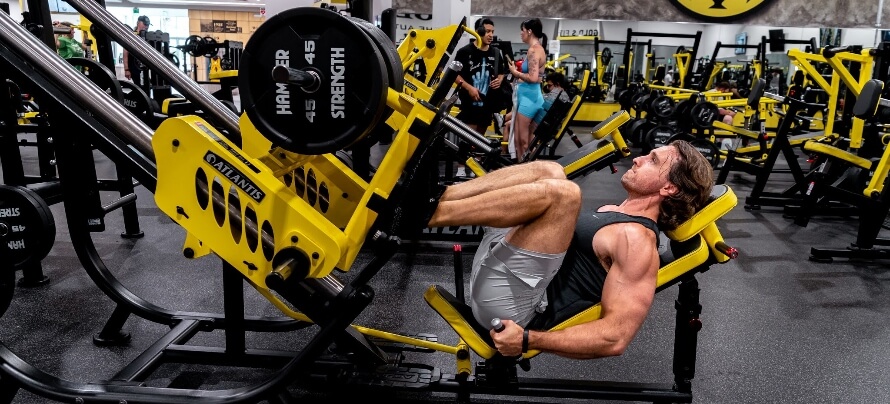
Most experts consider the barbell back squat the “king of exercises” because no other movement trains as many muscles throughout the body. It also lets you lift heavy weights safely and progress regularly, so it’s ideal for gaining muscle and strength.
That said, not everyone can or wants to barbell back squat.
For example, those with lower back problems may find putting weight on their spine uncomfortable. Similarly, people with knee issues may find it difficult to bend their knees to 90 degrees and beyond. In both cases, barbell back squats probably aren’t the best solution.
Barbell back squatting isn’t always ideal for beginners, either. Some find the technique tough to master, while others struggle to lift a 45-pound bar—the minimum required to perform a barbell back squat.
Then there are those who simply don’t enjoy back squats and prefer other leg exercises instead.
And that’s where barbell back squat alternatives come in.
The best alternative squat exercises reduce stress on your joints, offering a more comfortable option for those who find back squats uncomfortable. They also tend to be simpler, so they’re more accessible than back squats.
Good squat alternatives typically feel distinct enough from the back squat to be more palatable for those who dislike the exercise, too.
And crucially, they do all this without sacrificing muscle or strength gains.
In other words, the best barbell back squat alternatives help you build size and strength without any of the downsides of barbell back squatting.
The 9 Best Barbell Back Squat Alternatives
Here are my nine favorite alternatives to the barbell back squat.
These exercises are great substitutes because they train all the same muscles in your lower body—especially the quads, hamstrings, and glutes—along with other major muscle groups like the lower back, calves, and core.
If barbell squats feel like a struggle, try incorporating some of these alternatives into your routine. You’ll get all the gains without the grief.
1. Front Squat
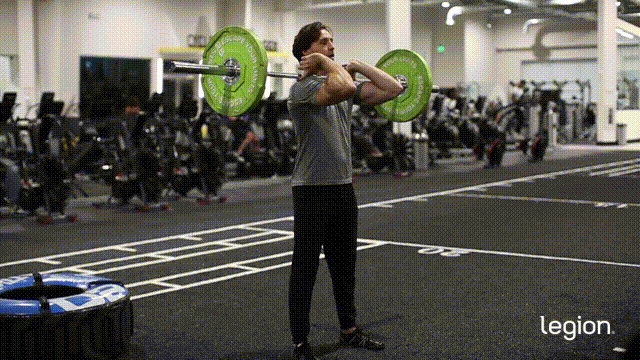
Why: The front squat is most experts’ go-to barbell back squat alternative because it trains the quads as effectively as the back squat, even when you use up to 20% less weight. It also places less compressive forces on your knees and lower back, so it’s more comfortable for people who have knee or back issues.
If, after several weeks of trying, you find the front squat “rack position” painful on your shoulders and wrists, consider switching to a “cross-arm” grip, or substitute the front squat for an exercise that trains your body similarly, such as the Zercher squat or hack squat.
How to:
- Place the barbell in a squat rack at about the height of your breastbone.
- Grip the bar with your hands shoulder-width apart, palms facing away from you.
- Step closer to the bar, so it rests on your upper chest, and raise your elbows in front of the bar.
- Lift the bar out of the rack, take 1-to-2 steps back, and position your feet slightly wider than shoulder-width, toes turned slightly out.
- Sit down, keeping your back straight, elbows up, and knees in line with your toes.
- Stand back up and return to the starting position.
READ MORE: How to Front Squat: Form, Benefits & Alternatives
2. Leg Press
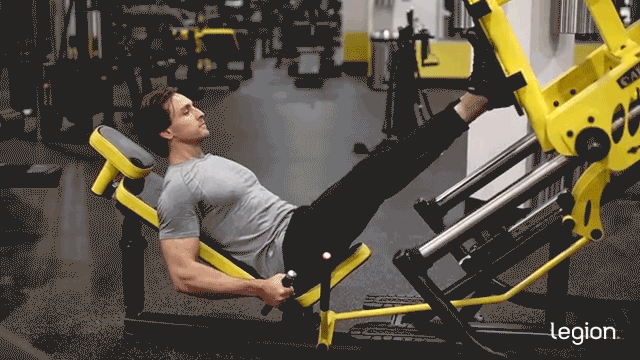
Why: The leg press is an excellent alternative to barbell squats because it trains all the same lower body muscles, but doesn’t require you to balance or support weight with your upper body and allows you to train with heavier loads compared to free-weight leg exercises.
This means it’s outstanding for gaining mass and strength, while being much gentler on your joints and soft tissues.
How to:
- Load the leg press machine with plates.
- Sit in the seat and wedge your butt down into the base.
- Place your feet halfway up the footplate, slightly wider than shoulder-width, with toes pointing slightly out.
- Straighten your knees and use the safety handles to release the weight.
- Lower the footplate toward your chest, keeping your back straight and thighs about 10-to-12 inches from your chest.
- Reverse the movement and return to the starting position.
READ MORE: How to Do the Leg Press: Benefits, Form, & Alternatives
3. Bulgarian Split Squat

Why: The Bulgarian split squat is a top-tier barbell back squat alternative because it trains your entire lower body one leg at a time, so it’s great for finding and fixing muscle imbalances and may even boost athletic performance more than barbell squats.
How to:
- Hold a dumbbell in each hand and stand 2-to-3 feet in front of a bench, with your back to it.
- Place your left foot on the bench behind you, keeping your right foot and heel firmly planted.
- Lower your body by bending your right knee, bringing your right thigh parallel to the floor.
- Stand back up and return to the starting position.
READ MORE: How to Perform Bulgarian Split Squats for Glutes, Hamstrings & Quad Growth
4. Step-Up
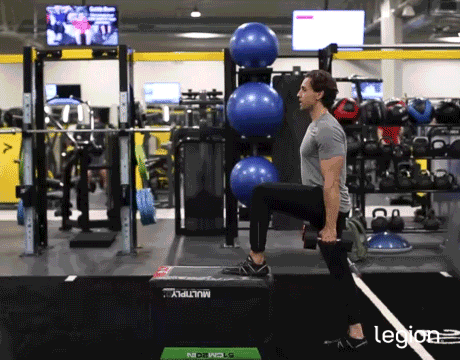
Why: The step-up is a first-rate barbell squat substitute because it trains your entire lower body, including your quads, glutes, and hamstrings. And since it doesn’t require you to lift heavy weights to be effective, it’s kinder to your bones and joints.
Moreover, research shows that the dumbbell step-up is a fantastic “accessory” exercise to the squat—it enables you to gain muscle and strength that boosts your squat performance without placing nearly as much strain on your body.
How to:
- Hold a dumbbell in each hand and place your left foot on a sturdy surface about knee-height off the floor.
- Keep your weight on your left foot and fully straighten your left leg.
- Lower your right foot toward the floor and return to the starting position.
READ MORE: Weighted Step-Ups Guide: How to Do Dumbbell Step-Ups
5. Lunge
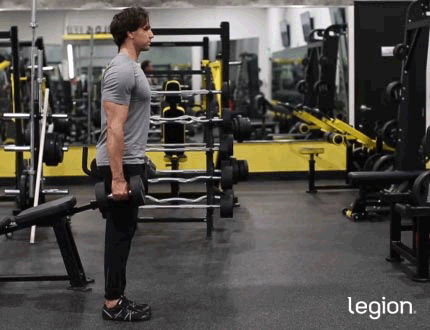
Why: The dumbbell lunge trains all your lower-body muscles and, because it’s a dynamic exercise that requires more balance and coordination than most leg exercises, it also engages smaller stabilizer muscles throughout your body.
How to:
- Hold a dumbbell in each hand and stand with feet hip-width apart.
- Take a long step forward with your right foot, about 2-to-3 feet.
- With most of your weight on your right leg, lower your body until your left knee touches the floor.
- Push off the floor with your right foot and lean slightly back, straightening your legs.
- Once standing, bring your right foot back to the starting position.
READ MORE: How to Lunge: Form, Benefits, and Variations
6. Trap-Bar Deadlift
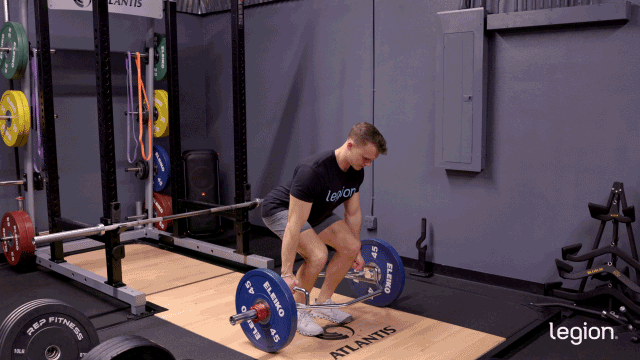
Why: The trap-bar deadlift engages the quads significantly more than other deadlift variations, and it trains the lower back and glutes to a high degree, making it the most similar deadlift to the squat and a viable squat alternative.
How to:
- Position your feet shoulder-width apart in the center of the trap bar.
- Hinge at your hips, slightly arch your lower back, and grip the handles.
- Push through your heels to drive your body upward and slightly back.
- Reverse the movement and return and the starting position.
READ MORE: How to Trap-Bar Deadlift with Proper Form (with a Free 12-Week Training Plan!)
7. Romanian Deadlift
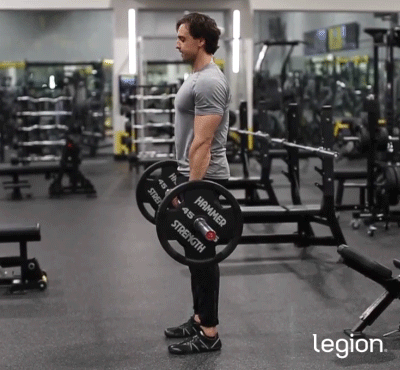
Why: The Romanian deadlift is an excellent back squat alternative for developing the posterior chain (the muscles on the back of your body), especially the glutes, hamstrings, and lower back muscles.
If the Romanian deadlift bothers your lower back, but you want to develop your hamstrings, try the leg curl instead.
How to:
- Stand holding a barbell with a shoulder-width overhand grip (palms facing you).
- Hinge at your hips, keeping your back flat, and lower the bar in a straight line, letting your hips move backward.
- When you feel a stretch in your hamstrings, bend your knees slightly and keep lowering the barbell until your back begins to round.
- Reverse the movement and return to the starting position.
READ MORE: How to Do the Romanian Deadlift: Form, Benefits, and Variations
8. Belt Squat

Why: The belt squat is a stable exercise that allows you to squat heavy weights without loading your spine. As such, it’s typically less fatiguing and easier to recover from than barbell squatting, so you can do it more often without wearing yourself out.
How to:
- Stand on the platform facing the machine and loop the belt around your waist.
- Squat down to hook the belt to the machine, then position your feet wider than shoulder-width, with toes pointing slightly out.
- Grab the machine handle with both hands, straighten your legs to lift the weight, and pull the handle to release it.
- Keeping your back straight, sit down and push your knees out in line with your toes.
- Stand up and return to the starting position.
READ MORE: How to Belt Squat for Quad Strength & Mass
9. Goblet Squat
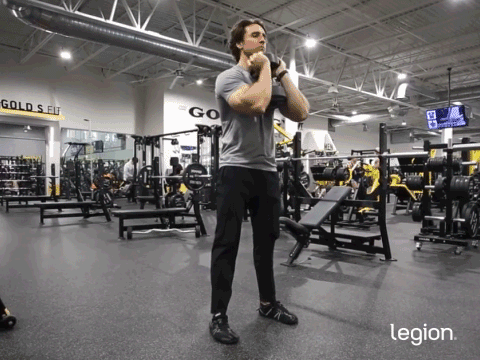
Why: The goblet squat is an effective exercise for training your lower-body muscles, particularly your quads. Because you hold the weight in your hands rather than across your shoulders, it’s also easier on your back than other squat variations.
What’s more, the goblet squat allows you to practice squatting with light weights for high reps, making it ideal for beginners. And since it requires little equipment and space, it’s also a great barbell squat alternative for at-home workouts.
How to:
- Hold a dumbbell in front of your chest with both hands.
- Place your feet slightly wider than shoulder-width apart, point your toes out to the side at about a 45-degree angle, raise your chest, and sit down.
- Remember to keep your back straight and push your knees out in the same direction as your toes throughout each rep.
- Stand up and return to the starting position.
READ MORE: Goblet Squat: Form, Form, Muscles Worked, & Common Mistakes
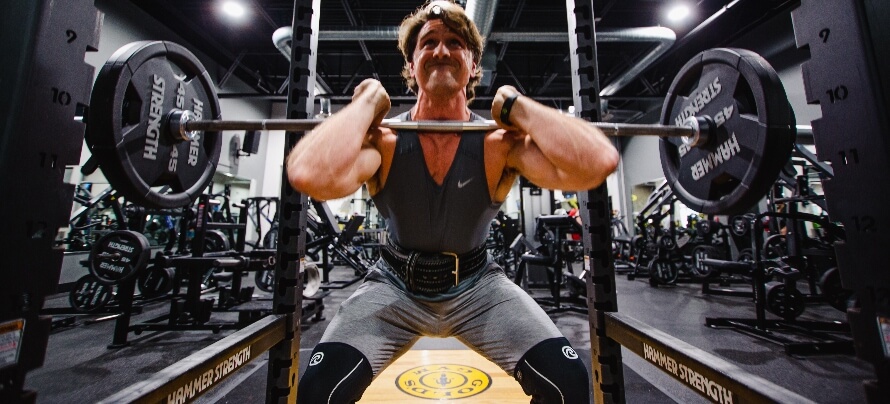
FAQ #1: What is the best alternative to squats?
There’s no single “best” squat alternative—it really depends on your goals and circumstances. For instance, the best squat alternatives for at-home workouts tend to be dumbbell exercises like the Bulgarian split squat, lunge, or goblet squat since these exercises require the least equipment and space.
However, if you want an alternative for gaining maximum mass and strength, an exercise that allows you to lift heavy weights safely and progress regularly will be better. In this case, the front squat, leg press, or belt squat would be more fitting.
FAQ #2: Can I build legs without squats?
Yes, you can build impressive legs without ever squatting. While squats are an outstanding exercise for gaining lower body mass, the alternatives discussed above will give similar results.
FAQ #3: What are the best at-home barbell back squat alternatives?
The best barbell squat alternatives for at-home training are the Bulgarian split squat, step-up, lunge, dumbbell Romanian deadlift, and goblet squat. These exercises only require dumbbells, making them ideal for home workouts where barbells or machines aren’t available.
If you don’t have any equipment, you can still build leg mass and strength with bodyweight alternatives like the bodyweight squat, pistol squat, and sissy squat. Just bear in mind that to continue gaining size and strength, you have to challenge your muscles with progressively heavier weights over time.
In other words, while these bodyweight squats might work initially, you’ll likely have to get some dumbbells or bands to continue making gains.
RELATED: What Is Progressive Overload Training?
Scientific References +
- Yavuz, Hasan Ulas, et al. “Kinematic and EMG Activities during Front and Back Squat Variations in Maximum Loads.” Journal of Sports Sciences, vol. 33, no. 10, 29 Jan. 2015, pp. 1058–1066, www.growkudos.com/publications/10.1080%25252F02640414.2014.984240/reader, https://doi.org/10.1080/02640414.2014.984240.
- Gullett, Jonathan C, et al. “A Biomechanical Comparison of Back and Front Squats in Healthy Trained Individuals.” Journal of Strength and Conditioning Research, vol. 23, no. 1, Jan. 2009, pp. 284–292, journals.lww.com/nsca-jscr/fulltext/2009/01000/A_Biomechanical_Comparison_of_Back_and_Front.41.aspx, https://doi.org/10.1519/jsc.0b013e31818546bb.
- Jones, Margaret T, et al. “Effects of Unilateral and Bilateral Lower-Body Heavy Resistance Exercise on Muscle Activity and Testosterone Responses.” Journal of Strength and Conditioning Research, vol. 26, no. 4, Apr. 2012, pp. 1094–1100, https://doi.org/10.1519/jsc.0b013e318248ab3b.
- DeFOREST, Bradley A., et al. “Muscle Activity in Single- vs. Double-Leg Squats.” International Journal of Exercise Science, vol. 7, no. 4, 2014, pp. 302–310, pubmed.ncbi.nlm.nih.gov/27182408/.
- Liao, Kai-Fang , et al. Effects of Unilateral vs. Bilateral Resistance Training Interventions on Measures of Strength, Jump, Linear and Change of Direction Speed: A Systematic Review and Meta-Analysis. 3 July 2021, pp. 2022;39(3):485-497, https://doi.org/10.5114/biolsport.2022.107024.
- Neto, Walter Krause, et al. “Gluteus Maximus Activation during Common Strength and Hypertrophy Exercises: A Systematic Review.” Journal of Sports Science and Medicine, vol. 19, no. 1, 1 Mar. 2020, pp. 195–203, www.researchgate.net/publication/339302672_Gluteus_Maximus_Activation_during_Common_Strength_and_Hypertrophy_Exercises_A_Systematic_Review.
- Simenz, Christopher J., et al. “Electromyographical Analysis of Lower Extremity Muscle Activation during Variations of the Loaded Step-up Exercise.” Journal of Strength and Conditioning Research, vol. 26, no. 12, Dec. 2012, pp. 3398–3405, https://doi.org/10.1519/jsc.0b013e3182472fad.
- Appleby, Brendyn , et al. Specificity and Transfer of Lower-Body Strength: Influence of Bilateral or Unilateral Lower-Body Resistance Training. Feb. 2019, pp. 33(2):p 318-326, https://doi.org/10.1519/JSC.0000000000002923.
- Marchetti, Paulo H., et al. “Balance and Lower Limb Muscle Activation between In-Line and Traditional Lunge Exercises.” Journal of Human Kinetics, vol. 62, no. 1, 13 June 2018, pp. 15–22, content.sciendo.com/view/journals/hukin/62/1/article-p15.xml, https://doi.org/10.1515/hukin-2017-0174.
- Ebben, W., et al. “Muscle Activation during Lower Body Resistance Training.” International Journal of Sports Medicine, vol. 30, no. 01, 30 Oct. 2008, pp. 1–8, https://doi.org/10.1055/s-2008-1038785.
- Swinton, Paul A, et al. “A Biomechanical Analysis of Straight and Hexagonal Barbell Deadlifts Using Submaximal Loads.” Journal of Strength and Conditioning Research, vol. 25, no. 7, July 2011, pp. 2000–2009, https://doi.org/10.1519/jsc.0b013e3181e73f87.
- Collins, Kyle S., et al. “Differences in Muscle Activity and Kinetics between the Goblet Squat and Landmine Squat in Men and Women.” Journal of Strength and Conditioning Research, vol. Publish Ahead of Print, no. 10, 2 Aug. 2021, https://doi.org/10.1519/jsc.0000000000004094.










